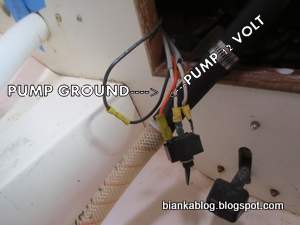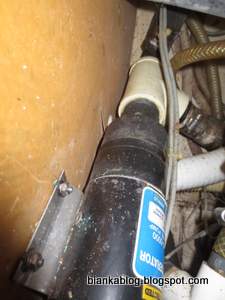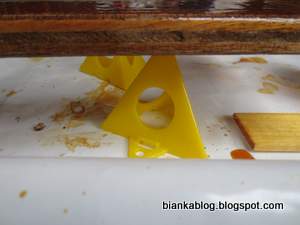Tuesday, June 30, 2015
MESSING ABOUT IN BOATS: Honda 2000i Oil Change Help
One of the maintenance rituals I do before launching is to change the oil in the Honda 2000 EU generator. I've been able to significantly reduce the the mess of this procedure by using a Hopkins Measure Funnel:
While this eliminates a lot of the mess of the oil changing procedure I still...
Friday, June 26, 2015
FIXING A HOLE: HEADLINERS AND HANDRAILS
Builders of production boats have tended to put decorative headliners into their design so they could make them all nice and pretty for some buyers. The sleek clean interior helps sell boats along with other useless things like three burner stoves and ovens. While headliners make things all nice and "purty" they can also cover up deck fittings that are leaking and also make maintenance of deck mounted items harder. As I found out several years ago when I decided to remove and remount the handrails on BIANKA. The boat builder drilled small little holes in the liner to access the screws that held the handrails to the deck:
They then covered the holes with small plastic caps. It looked neat but, it was a pain when I started on the project to remove the hand rails so I decided to...
They then covered the holes with small plastic caps. It looked neat but, it was a pain when I started on the project to remove the hand rails so I decided to...
Labels:
access,
boat project,
CABIN,
cetol,
dremel,
DREMEL TOOL,
GRABRAILS,
HANDRAILS,
headliner,
liner,
painters points,
project
Sunday, June 21, 2015
A WASTE OF TIME
Sometimes you just have to know when to stop doing some optional maintenance that is going to turn out to be more of a problem than it's worth. A while ago I had two equipment failures located in the same area and sharing the same wiring. One was the anchor washdown pump and the other was the Jabsco macerator pump. Since they both were fed from the same breaker and stopped working at the same time I thought it was too much of a coincidence that they both would fail at the same time. It was not. I worked on the Flojet washdown pump first and found it's problem was a faulty corroded pressure switch. Then a week ago I decided to finally take a look at the macerator pump issue. Since I thought at first it might be a power issue I decided to rewire the pump using Anderson Power Pole connectors. Using the30 amp connectors would make removing and testing the pump easier now and in the future. It would also help clean up some of the wiring. The macerator pump power was originally operated through a on/off /on switch that powered the washdown pump or the macerator pump depending on which position the switch was set:
So I wired two Powerpole connectors directly to the pump power wires:
I found some trouble shooting info on one of the sailing websites that some times the macerator pump is jammed. But, there is a cap on the back of the motor that could be removed and a screwdriver inserted onto the macerator pump motor shaft to turn it and clear the jam. Unfortunately, my twenty eight year old pump must have been one of the early ones and did not have the mentioned cap. So it looks like I will have to remove the pump to investigate further. In addition a ball valve on the output of the pump was jammed and would not budge. Since the input to the macerator pump also had a T that also connected to the holding tank output. Taking the pump out would now make the holding tank unable to be emptied by the usual means like a pump out:
So I decided that this project would be best done in the off season when I have more time to deal with working in the confined space where these components are located. My time is better spent now getting the boat ready for launching for the season. Sometimes you just have to know when to stop on some projects.
Labels:
boat maintenance,
flojet pump,
HEAD,
holding tank,
macerator pump,
maintenance,
plumbing,
pump,
pump out,
valve
Thursday, June 18, 2015
MORE STUFF THAT'S NOT NEEDED
It seems organizing and removing of things on board that have no reason to be on board is never ending. A few days ago while looking for some information on one of the on board pumps I came upon some manuals for equipment that is no longer on board:
These include the Paloma Water Heater. The old Professional Mariner battery charger and the Racor fuel filter which has not been on board for over eight years. No reason for these to remain on board taking up space. Plus it feels good to get them of the boat and simplify things.
These include the Paloma Water Heater. The old Professional Mariner battery charger and the Racor fuel filter which has not been on board for over eight years. No reason for these to remain on board taking up space. Plus it feels good to get them of the boat and simplify things.
Labels:
BATTERY CHARGERS,
cleaning,
organizing,
paloma,
racor,
water heater
Saturday, June 13, 2015
USEFUL THINGS ON BOARD: PORTABLE WORK TABLE
While I was getting things ready for launching this spring I came across an old cutting board stored away at home. I thought it might be useful on board so I came up with an idea to make it useful as a portable work table. Using some scrap wood from an old bed frame and a couple of screws I soon had a very useful surface to work on around the boat. One place where I could use a work table space is in the aft quarter. Perhaps using the stainless steel pushpit railing for a support. I then thought how I could secure the cutting board from slipping off the rail. That's when I found the old wooden bed frame that already had a strip of wood running along an edge that would be perfect for the function:
After securing it to the cutting board with a few screws it was ready for a test fitting:
Perfect. The wooden lip will prevent the surface from sliding off the rail. I will probably install another strip so the rail fits between the two strips at some point but, this is fine for a start. I then took another piece of the old bed frame and screwed it into a position where it would sit on the cockpit coaming while the other board was sitting on the stern rail:
While most items would not roll off the work table at this angle having a flat surface would be better. So looking around while putting on my "use what you got hat" I found that two 12 oz aluminum cans sitting on the coaming surface make for a perfectly level work surface:
Plus turning the work surface sideways allows for an even more secure work surface thanks to those edge strips:
I think this portable work table is going to come in very useful on board for a number of projects in various spots around the boat. I will continue to report the new uses for it as they appear.
After securing it to the cutting board with a few screws it was ready for a test fitting:
It tilts down at a slight angle but, not too bad.
While most items would not roll off the work table at this angle having a flat surface would be better. So looking around while putting on my "use what you got hat" I found that two 12 oz aluminum cans sitting on the coaming surface make for a perfectly level work surface:
Problem solved! I also found another area where this portable work surface comes in very useful. I spent some time varnish the fold down cockpit table on BIANKA. I would prefer not to have to do this too often. I found my new portable cutting board work table fits nicely on top of the fold down table top while protecting the varnish job. It also provides a handy work table service for projects at the same time:
I think this portable work table is going to come in very useful on board for a number of projects in various spots around the boat. I will continue to report the new uses for it as they appear.
Labels:
cockpit,
cutting board,
surface,
table,
tools,
useful stuff
Wednesday, June 10, 2015
ANOTHER ELECTRIC PROPULSION MILESTONE
Eight years after I installed electric propulsion in BIANKA I have never looked back or regretted it. It has reduced maintenance and cost close to zero so that I can concentrate on other things like refinishing the galley area and on deck brightwork. Still I do try and keep an eye on all things involving electric propulsion. I came across this article today involving electric propulsion drive train in trucks. Some quotes that stood out to me:
"Twelve years ago, Ian Wright and some fellow engineers launched Tesla Motors, a Silicon Valley company that has helped jumpstart the market for electric cars. Now, the Tesla co-founder wants to electrify noisy, gas-guzzling trucks that deliver packages, haul garbage and make frequent stops on city streets."
A noisy garbage truck with brakes squealing in early mornings while making frequent stops collecting trash may be a thing of the past. Having the ability for repetitive regenerative braking makes a lot of sense for such a vehicle. As does regen on boats like BIANKA. Helping to recharge the batteries while doing something useful and the high torque availability makes sense too!
"A truck with a Wrightspeed powertrain can run on batteries for about 30 miles before the turbine, which runs on diesel or natural gas, kicks in and recharges the battery. The system roughly doubles the fuel efficiency of trucks and reduces the cost of maintenance"
This is pretty much the same technique I use on BIANKA and it has worked well for the past eight years and the maintenance costs for the boat has dropped precipitously. Good to see these ideas starting to make their way back on land too.
Saturday, June 06, 2015
USEFUL TOOLS: PAINTERS POINTS
Because of the cold water temperatures I've been putting off the launching of BIANKA this year. So I've been doing a lot of maintenance items like varnishing and touching up some of the wood trim on board. Much easier when the boat is on solid ground anyway. Because one normally can only put varnish or paint on one side of an item it takes two days to do both sides of say a wood trimmed screen hatch. But, one can also speed things up and do a coat a day if one uses Painters Points .
.


These neat little plastic pieces allow you to not only raise an item you need to paint off the surface so you can paint all the way to the bottom without it sticking to what's underneath it. But, you can also do one side a flat piece and then using the points to support the piece put a coat on the other side of the item. This allows you to put a coat on the whole piece in one day. The Painters Points can hold up to 200 lbs. I don't have anything nearly that heavy that I will be varnishing on board. But, even the small items I do have to maintain are done much faster without waiting an extra day for one side to dry. They also stack nicely for storage and don't take up a lot of room when not in use. Which is important on a boat. They came in very useful in varnishing the forward overhead screen hatch:
The points can be arranged to best support the item you are painting or varnishing:
I also used them when putting fresh coats of Cetol on the boarding ladder steps:
on the boarding ladder steps:
In short if you do a lot of refinishing on board these Painters Points come in very handy and can help speed up your projects.
.
These neat little plastic pieces allow you to not only raise an item you need to paint off the surface so you can paint all the way to the bottom without it sticking to what's underneath it. But, you can also do one side a flat piece and then using the points to support the piece put a coat on the other side of the item. This allows you to put a coat on the whole piece in one day. The Painters Points can hold up to 200 lbs. I don't have anything nearly that heavy that I will be varnishing on board. But, even the small items I do have to maintain are done much faster without waiting an extra day for one side to dry. They also stack nicely for storage and don't take up a lot of room when not in use. Which is important on a boat. They came in very useful in varnishing the forward overhead screen hatch:
The points can be arranged to best support the item you are painting or varnishing:
I also used them when putting fresh coats of Cetol
In short if you do a lot of refinishing on board these Painters Points come in very handy and can help speed up your projects.
.
Labels:
boat maintenance,
brightwork,
cetol,
maintenance,
painters points,
PAINTING,
tools,
varnish,
varnishing
Tuesday, June 02, 2015
ANOTHER IMPROVEMENT IN ENERGY SAVINGS
When I first bough BIANKA in the fall of 1995 she had two clip on lamp fixtures each with a 60 watt incandescent bulbs. I used them for the cabin illumination when I was tied up to the dock as they used 120 volts AC. They worked well as long as you did not drop them when they were on as the hot filaments were very fragile. I replaced them a number of times. Then a few years ago along came compact florescent lights. They only used about 16 watts for the same amount of light as the delicate 60 watt incandescent they replaced. They were not as susceptible to damage but, I still did manage to break one in the cabin when it fell. Since these lamps also contain mercury it is a good idea to clean it up ASAP. This spring in order to avoid another accidental mercury spill this spring I bought some new TCP LED 60 Watt Equivalent Light Bulbs
Labels:
bulbs,
compact florescent,
energy,
energy savings,
illumination,
inverter,
LED,
LEDS,
lighting,
LIGHTS,
lumens
Subscribe to:
Comments (Atom)





























.jpg)


